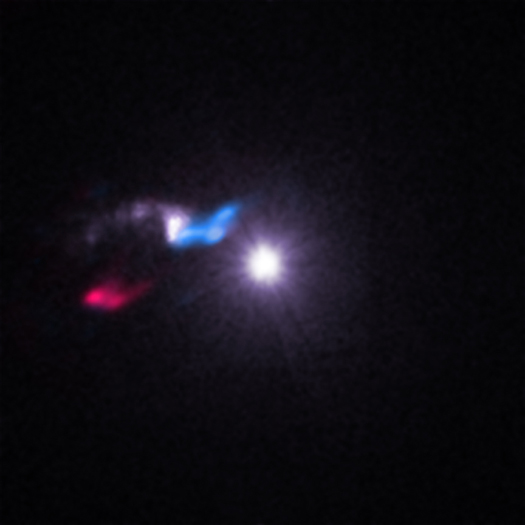Cygnus X-3 and Its Little Friend

Michael McCollough
We are pleased to welcome Dr. Michael McCollough as our guest blogger. Dr. McCollough is the first author of a paper that is the subject of our latest press release. He has spent the last 30 years working with and analyzing data from astronomical radio, optical, X-ray, and gamma-ray telescopes. Currently, he serves as an Archival Astrophysicist at the Chandra X-ray Center in Cambridge, Mass.
Throughout my career I have been a multi-wavelength astronomer. To fully understand astronomical objects, one must look across the electromagnetic spectrum (from radio waves to gamma-rays). Also throughout my career I have been doing spacecraft operations. Starting with NASA’s Hubble Space Telescope (before, during, and after launch), ROSAT, NASA’s Compton Gamma-Ray Observations with the Burst and Transient Source Experiment (BATSE), and currently with NASA’s Chandra X-Ray Observatory. It was when I was working with BATSE that I was introduced to Cygnus X-3. Discovering that high-energy X-rays (as seen by BATSE) were correlated with emissions in the radio.
Cygnus X-3 is a high-mass X-ray binary that consists of a compact object (either a black hole or a neutron star) in orbit with a type of massive star called a Wolf-Rayet Star. A Wolf-Rayet star has evolved to the point where strong winds have already ripped off the outer hydrogen envelope and the star is now made up of helium and heavier elements. The compact object is very close to the Wolf-Rayet star, orbiting it every 4.8 hours. Cygnus X-3 is a bright X-ray source because material that is pulled away from the Wolf-Rayet star by the compact object – in a process called accretion – becomes hotter and shines in X-rays.
Cygnus X-3 is also a bright radio source producing jets that travel close to the speed of light (i.e. relativistic jets) and powerful radio flares that at times make it one of the brightest radio sources in the Galaxy. This makes Cygnus X-3 part of a class of objects known as microquasars. A quasar is powered by a supermassive black hole with millions or billions of solar masses that produces relativistic jets by accreting material. A microquasar, on the other hand, is powered by either a black hole weighing 5 to 30 times the mass of the Sun or a neutron star that produces relativistic jets by accreting matter from its companion.
In 2000, Chandra made an observation of Cygnus X-3 to study its X-ray spectrum, that is, the X-ray intensity measured at different energies. In this observation an X-ray source was found 16 arcseconds away from Cygnus X-3 (this separation is roughly the angular size of a penny observed from the distance of three football fields). Chandra is the only X-ray telescope we have right now that has high enough resolution to see both of these close objects. In 2006, another Chandra observation was made to study its X-ray spectrum during a brighter state and make a more detailed study of the nearby source to Cygnus X-3. We found the source to be extended (not a point source) and that it varied in X-ray intensity with the same 4.8-hour period of Cygnus X-3 (but delayed in time). Because of the location of the feature relative to Cygnus X-3 and the similar variability, we started calling it the "Little Friend".
From an analysis of the Little Friend's X-ray spectrum, variability and intensity we arrived at the conclusion that what we were seeing was an X-ray mirror where the Little Friend is reflecting the X-rays from Cygnus X-3. We are seeing X-ray scattering by dust in a small cloud that is very close to the line-of-sight to Cygnus X-3. The delay in the X-rays gives us the location of the Little Friend relative to Cygnus X-3. Using this information we can deduce the size, density and mass of the Little Friend. From this we concluded that the Little Friend was a small dense cloud called a Bok globule. This represents the first detection of a Bok globule in X-rays.
Bok globules are typically seen in optical light as small dark clouds seen against bright nebulas. They are very cold (10-20 degrees above absolute zero) and are mostly made of molecular gas and dust. To confirm the Little Friend is a Bok globule we obtained observations with the Submillimeter Array (SMA). Within the SMA data, we detected emission by the molecule CO, thus confirming that the Little Friend is indeed a Bok globule. Somewhat unexpected was our discovery that the Little Friend, like Cygnus X-3, has its own set of jets. Although in the case of the Little Friend, the jets are made up of molecular gas and are much slower than those found coming from Cygnus X-3. What this means is that the Little Friend has given birth to a protostar marked by the jets. Thus we have in the same field of view a picture of the stellar cycle of life. We have Cygnus X-3 marking stellar death, the Little Friend as the stellar nursery and the CO jets marking the birth of a star.
Another result that we obtained from the SMA observations was the velocity of the Little Friend with respect to the Earth. If we assume this velocity is mostly due to Galactic rotation we can determine the distance to the Little Friend. Our estimate puts the Little Friend in the Perseus arm of our Galaxy right where the local arm we are part of merges into it, exactly where one would expect star-formation to occur. This is roughly 20,000 light years from us.
Also from the delay between the X-ray variations of the Little Friend and Cygnus X-3 we can now better determine the distance to Cygnus X-3. Previously there was a factor two uncertainty in its distance. We find it lies between the Perseus arm and the Outer arm of the Galaxy at a distance of roughly 24,000 light years (with a 15% uncertainty). This is a little surprising as we would expect Cygnus X-3 to be in a star-forming region (in or near one of the Milky Way’s spiral arms) because that’s where Wolf-Rayet stars are typically found. The most natural explanation is that Cygnus X-3 formed near the same region where the Little Friend is found. But when the compact object formed as a result of a supernova explosion, the X-ray binary received a kick that sent it flying out of the spiral arm with a velocity of over 100,000 miles per hour.
The story continues as we seek to better understand the Little Friend and Cygnus X-3. We are working with infrared and X-ray spectra of Cygnus X-3 to better constrain the kick velocity it received after forming. We are also using imaging software to produce a higher-resolution X-ray image of the Little Friend. Recently we have had new SMA observations to produce higher resolution images of the Little Friend and its associated jets to better understand its structure relative to what we see in X-rays.
Stay tuned for future results.
- Log in to post comments

